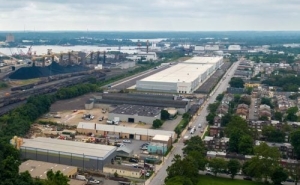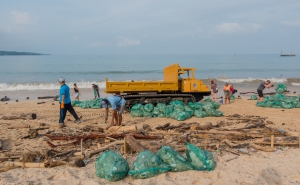Designing for a Wetter Future
Environmental engineering students partner with Baltimore City on a concept to protect a major wastewater treatment plant from future climate-driven impacts
The Design Day team members, from left, Emily Klaus, CJ Cole, Joey Stanley, and Rick Montiel, visit the Back River Wastewater Treatment Plant. Not pictured is team member Lalitha Aiyar.
A team of Johns Hopkins University seniors studying environmental health and engineering is working with the City of Baltimore to reduce future flood risks at one of its two wastewater treatment plants. With sea levels rising, increasing storm surges, and more frequent flooding events predicted, the Back River Wastewater Treatment Plant could face serious damage or disruption over the next several decades unless the city takes steps to prepare.
“This real-world challenge is being confronted by engineers and scientists all over the globe as they struggle to find adaptable, resilient solutions that will protect critical infrastructure and natural resources. Providing our students with this project will give them the skills to help them excel in our changing world,” said Chris Overcash, lead instructor for Senior Environmental Engineering Design in the Department of Environmental Health and Engineering.
The students will present their project on April 29 at the Whiting School of Engineering’s Design Day, the school’s annual event showcasing students’ creativity, innovation, and ability to translate theoretical knowledge into solutions to real-world problems. The team will also share their findings in a report to the Department of Public works and city leadership.
Situated on the western shore of the Back River on Eastern Avenue in Baltimore City, the Back River Wastewater Treatment Plant treats an average of 180 million gallons of wastewater per day. If the plant were to fail, untreated sewage and wastewater would be released into the environment, contaminating water sources, harming wildlife, and posing human health risks. The Hopkins team proposes to protect the facility through a combination of constructed wetlands and physical barriers.
“The Back River Wastewater Treatment Plant is a crucial part of Baltimore City’s infrastructure,” said team member Joey Stanley. “Preventing failures, maintaining water quality, and ensuring long-term service reliability is essential to safeguard the environment and public health.”
Why a hybrid solution?
The team’s recommendation is two-pronged: Construct a wetland to prevent erosion from rising sea levels and the eroding force of waves over time, and erect more traditional barriers to prevent large storm surges from inundating the plant. This approach melds nature-based solutions with more traditional structural ones.
“Wetlands capture a lot of water,” said Stanley. “Besides reducing flooding, natural solutions like wetlands have a lot of added benefits. They filter out contaminants, support natural ecosystems, and reduce erosion.”
Wetlands are also resilient and can generally withstand hurricanes unscathed. However, they are less effective at stopping a large storm surge from inundating the plant. For that, you need physical barriers, said Stanley.
"Let's say a Category 4 or 5 hurricane rolls in and gigantic waves are crashing, and the sea level has risen to a certain amount by some year in the future. A wetland will only help to protect and reduce wave impact. It will survive it, so the shoreline will stay where it was. But to protect the plant against a high-water event, you do need some form of hard infrastructure,” he said.
The Design Day experience
While the Hopkins team’s design is conceptual at this stage, the process of analyzing data, making site visits in different conditions, and working with professionals to design a solution to a real-world problem was a great experience for team members. Comparing water levels at the plant in dry weather and during a rainstorm, coupled with projections based on NOAA data, defined the trajectory of their project.
“We went out to the site when it was really calm, and it seemed like the facility infrastructure was well above the river. Then we visited during a really heavy rainstorm and saw waters from the Back River encroaching in a lot of areas. Getting that hands-on experience was really helpful,” said team member CJ Cole.
Between the two visits and the depictions of anticipated sea level rise mapped using NOAA data input into GIS systems, the team came up with a set of potential solutions.
“You can see whole swaths of the plant being underwater based upon future projections of sea level rise. It really spoke to us to do something about that,” said Cole.
Team members are Stanley, Lalitha Aiyar, CJ Cole, Emily Klaus, and Ricardo Montiel.





